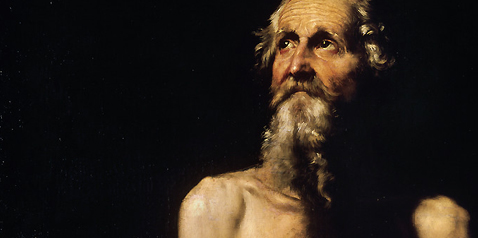
ALONE IN THE DESERT
Jusepe de Ribera
St Paul the Hermit, 1647
If you could afford a Ribera, you were doing well. The surroundings in which this picture found itself in its day probably contrasted strongly with the ascetic life of the saint it venerates. At the same time, the death’s head which the hermit is holding in his emaciated arms reminded the buyer of the transitoriness of his earthly prosperity.
Since the 1630s, Ribera had depicted St Paul the Hermit in a number of ways. He was revered as the first Christian hermit. His clothing consists of an apron woven from palm straw. On a table to the left, we see a book, symbolizing his spiritual exercises, and a scrap of dry bread, pointing to his abstemiousness.
The bright incident light from the top left concentrates attention on the figure of the saint and sets him off against the deep darkness of the background. His face, lost in thought and turned towards the light, bears witness both to his inner contemplation as does his calm physical posture. The double function of this source of light is clear: In its physical character, it serves not only to illuminate the saint, but on a transcendental level also has the task of ‘enlightening’ him. Every detail of the picture leads back to its real purpose: to engender devotion in the beholder through the exemplary figure of the saintly hermit.
Jusepe de Ribera
Játiva/Valencia 1591 – 1652 Neapel
St Paul the Hermit
c. 1647, oil on canvas, 130 x 103.5 cm
Acquired in 1936 as part of the Carstanjen collection
Inv. no. WRM 2553
Photo: Rheinisches Bildarchiv Köln



